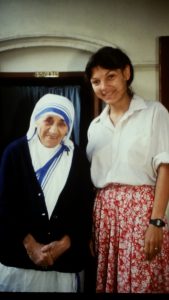Thanks to the Catholic News Agency for this beautiful article about my life-transforming experience working with Mother Teresa. It is reprinted here with their permission.
Women’s rights activist Reggie Littlejohn is known for her fierce work fighting forced abortion and gendercide in China, often through grilling speeches given before the U.S. Congress and the United Nations.
However, what is less-known about Littlejohn is that before becoming a successful lawyer and founder of the Women’s Rights Without Frontiersorganization, she spent six weeks working alongside a tiny, hunched-over woman in India who would become one of the greatest figures of our time.

Reggie Littlejohn and Mother Teresa in 1987
While on a yearlong break from Yale Law School, Littlejohn traveled the world alongside her husband, stopping to work with the Missionaries of Charity in Calcutta, now referred to as Kolkata, for just over a month.
It was during this time that Mother Teresa not only asked Littlejohn to be her ‘Apostle of the Rosary’ during their daily holy hour, handing rosaries to everyone that entered, but invited her to join the order.
Although she couldn’t join since she was already married, Littlejohn said she probably would have been willing to, thanks to Mother Teresa’s humility, personal closeness to each individual, and selfless service to others.
Mother Teresa “was a humble person, she did not consider herself to be any better than anyone else,” Littlejohn told CNA.
When people told Mother Teresa that she was a saint, she would reply “‘no, I’m just holy in my state in life, just the way that you’re holy in your state of life,’ assuming that we’re all holy in our state in life,” Littlejohn said, adding that “I think most of us are not. But she had no sense of self-importance of all.”
Littlejohn, who grew up Catholic, said she wanted to me “a missionary nun” when she was a child, and consistently pestered her parents with the idea. However, she was eventually dissuaded by them and their parish priest, who told her the lifestyle was probably not for her.
“I guess if I had been more determined or a true saint like Mother Teresa I would have gone on,” she said, but instead gave up because “I figured that if the priest said no, this is not the will of God.”
However, when she heard about Mother Teresa and the Missionaries of Charity several years later and discovered that volunteers could meet and join them in their work, she was “of course enthralled by the possibility.”
She said her desire to work with Mother Teresa in slums stemmed from “a powerful spiritual experience,” since one can work with the poor and impoverished anywhere.
“Why go to India, why work with a monastic community? It’s because I felt that there was something spiritually powerful about them that I wanted to experience, and I think that I did experience it.”
This experience is something Littlejohn felt from the moment she and her husband showed up at the Missionaries of Charity doorstep, where they were not only “welcomed right in,” but met Mother Teresa face-to-face the same day.
Littlejohn said she and her husband were sitting in the hall waiting to get a list of suggested places to stay and work, when they heard “this little rustling and shuffling down the hall.”
“We looked down the hall and there was Mother Teresa herself, and she immediately came to both of us and she took our hands in her two hands,” she said, recalling how the soon-to-be-saint’s hands were “big, and soft and warm.”
The first words out of Mother Teresa’s mouth were “welcome, welcome. Good. I’m so glad you’re here,’” Littlejohn recalled, noting that “we had just walked in off the street and here she is.”
“One of the characteristics of Mother Teresa is that she regarded every human being as Jesus Christ right in front of her… (even) a baby that she found in a trash can…when she was with you she was with you.”
Although Mother Teresa was typically traveling to the various Missionaries of Charity houses all over the world, Littlejohn noted that the nun was in Calcutta for the entire six weeks she and her husband stayed, which was an “unusual” but welcome blessing.
Speaking of Mother Teresa’s generosity and attention to others, Littlejohn recounted how her parents came to visit while she was working there, and at one point asked to have a photo with the nun.
“Being the immature person I was, I had the audacity to knock on the door – it was really more of a doorframe with a curtain in it – during their time of rest” and ask for the photo, she said.
Instead of telling them to come back, Mother Teresa came out “very good natured” and embraced her parents, consenting immediately to the photo.
“She was very cheerful, she stood there giving up her naptime to take a picture with some American whose parents were visiting Calcutta,” Littlejohn said, adding that “She was so un-protective of her time, and this was her humility.”
Littlejohn also recounted how she received the role as ‘Apostle of the Rosary’ during her time with the Missionaries. During their stay, volunteers had the option of going to Mass with the sisters at 5:50 a.m., and joining them for Holy Hour and the rosary at 6:30 p.m. after the day’s work.
The first time she attended a holy hour, Littlejohn said she was late, and “snuck in the back door” so as not to disturb the others, or Mother Teresa, who was praying on the other side of the room.
“I went far away from her and was trying to creep in unnoticed,” she said, but as she was kneeling and praying, “all of the sudden I felt this presence above me, and I looked up and there was Mother Teresa.”
Instead of chastising Littlejohn for being late, Mother Teresa “bent down and showed me which bead they were on, which is again her humility… (she) interrupted her own prayer to show me which bead we were on.”
Littlejohn said she decided to come to holy hour again the next day, and arrived on time. When she got there, Mother Teresa pulled her aside and said, “I would like you to help me. Would you be my Apostle of the Rosary?”
“What do you say to that? I was floored that she even noticed me at all,” Littlejohn said, explaining that she consented and was tasked with handing a rosary to each person as they walked into holy hour for the rest of her time there.
In addition to her spiritual support, Mother Teresa was also a source of comfort and strength after Littlejohn had been assaulted by a man while waiting for the subway.
“There is a long walkway in a tunnel to get to the subway and I was the only person in the tunnel with this guy, and he just turned around and grabbed me,” Littlejohn said, explaining that she tried to punch the man and chase him down, but wasn’t able to because she was wearing sandals.
Upset about the incident and finding it hard to carry on with her work, she approached Mother Teresa later that evening. Littlejohn said she was fearful that Mother Teresa would chastise her and say she should have “turned the other cheek,” however, what she heard was the opposite.
Mother Teresa, she said, told her it was a “grace from God” that she tried to chase the man down, and applauded her effort to catch him. However, she also cautioned her that it’s “unwise to ever go out as a woman alone,” which is why the Missionaries always go out two-by-two.
After the conversation, Littlejohn said Mother Teresa took time to pray with her, and in the end she left feeling “so elated, much more so than if it had never happened.”
“This is the time she takes for one person, I mean who was I? I was nobody, I was a volunteer among many dozens of other volunteers who were there at that time, I was among thousands of volunteers who had been there over the decades and she took the time to listen to my story.”
Littlejohn then recalled how at one point during her stay, Mother Teresa actually invited her to join the Missionaries of Charity.
The sisters had periodic spiritual retreats, and that there was always a certain time or talk that the volunteers could attend. One of the retreats, Littlejohn noted, was dedicated to the topic that “everyone on earth has a heavenly name” that they will discover only when they get to heaven.
As she was leaving the retreat alongside the stream of other volunteers, Littlejohn said Mother Teresa happened to be right outside the room, and walked straight up to her.
Mother Teresa, she said, “came up to me and took my hand in her two hands and she said, ‘Heart full of Love, you must take the sari,’” referring to a typical Indian garment worn by women.
The habit for The Missionaries of Charity is a white sari with blue lines running along the edges, representing both purity and the Virgin Mary.
“I felt like she was calling me by my heavenly name,” Littlejohn said, explaining that Mother Teresa’s words “you must take the sari” were a direct invitation to come live with the community for two weeks, to discern whether or not it might be her vocation.
Littlejohn said she had wanted to say yes, but couldn’t, since she was already married – a fact that shocked Mother Teresa, who “in her purity” never realized the man coming and going everywhere with Littlejohn was her husband, despite the fact they both wore their wedding rings.
Mother Teresa then invited the couple to become Lay Missionaries of Charity, taking them to the small room the size of a restaurant booth that served as the administrative headquarters of the order.
While Littlejohn was accustomed to spacious legal “war rooms” stacked to the ceiling with documents, “there was none of that with Mother Teresa.”
“She had one little rickety file cabinet” from which she pulled the typewritten copy of the rules for the Lay Missionaries of Charity. It was the only copy.
“I just looked at this document and I thought to myself, ‘if I were an irresponsible person and just walked off with this without returning it to her, she would not have the rules of the Lay Missionaries of Charity, it would be gone,’” Littlejohn said, but noted that this is how Mother Teresa lived.
“She lived such a life of faith that she just depended completely on God,” for both the small things and the big.
After going through the rules and discussing them together, Littlejohn and her husband came to the conclusion that being lay missionaries with the order, while beautiful, wasn’t for them.
However, even though they said no, “I feel that my experience with Mother Teresa has had enormous influence on my life,” Littlejohn said, adding that the order’s ministry of picking up dying babies off the street “is the spiritual inspiration” of the Save a Girl Campaign her organization is promoting in China.
The difference between the two is that while Mother Teresa and her sisters would shelter and care for dying or rejected babies, Littlejohn’s organization encourages mothers to keep their daughters, giving them a monthly stipend to help with expenses.
While her organization works to fight gender discrimination in China, Littlejohn said that it was in India that she first encountered female gendercide.
While on a trip to India before working with the Missionaries of Charity, Littlejohn said she had been visiting Varanasi, and that as she was stepping from the shore of the Ganges River into a small motor boat for a ride, “I look down and right beneath me was a fully formed, dead baby girl floating in the water.”
“I was aghast,” she said, explaining that the baby “looked absolutely perfect. It did not look like a child that had died from some kind of illness, this was a perfectly beautiful baby girl, and I’ll never forget it.”
Working with Mother Teresa and her order prompted Littlejohn to both take another look at the faith of her childhood, and to look more closely to the needs of others.
“One of the things that I learned with Mother Teresa (is) what your limits are; you learn what the limits to your holiness are, you learn to expand your limits,” she said, explaining that at first she was afraid to touch people with diseases, for fear of contamination.
However, “as you continue working your compassion for the person grows, so you stop thinking so much about yourself and you start thinking more about them and what they’re going through and wanting to somehow relieve their suffering,” she said.
She referred to the phrase “I Thirst,” which was inspired by Mother Teresa and is written on the wall beside a crucifix in every Missionaries of Charity house.
“Loving Jesus in the distressing disguise of the poorest of the poor, as she would call it, was satisfying his thirst for souls,” she said, explaining that the phrase serves as an inspiration to her and her work.
While her organization has a “justice-oriented mission,” exposing forced abortion and sex-selective abortion in China, Littlejohn said “there’s this whole mercy aspect of it, which is helping these women and baby girls, these women who do not want to abort,” and offering a new, countercultural message that girls are just as good as boys.
“I think that’s very in line with what Mother Teresa was doing, and she’s a profound inspiration to me in the entire direction of my life.”
In a letter she wrote to friends and family while in Calcutta, which was later published in the Yale Law Report, Littlejohn described Mother Teresa as “a short woman in her mid-seventies, bent at mid-back as if in a permanent posture of prayer.”
“Her face is lined with love, and her deeply crinkled eyes pour out compassion. She is in such a state of grace that when she takes your hand, smiles and says, ‘God bless you,’ she opens the inner chambers of your soul and leaves you ecstatic for hours.”
As someone born into an upper-class Albanian family, Mother Teresa is proof that “even those of us with privileged pasts can aspire to goodness,” Littlejohn said, explaining that the nun “seems blissfully unconcerned about her stature in the world.”
“I don’t think she even thinks about how others view her. She just loves people, especially the poor, and caresses the hand of the leper with the same joy and respect with which she kisses the hand of the Pope or shakes the hand of a president.”
Littlejohn described Mother Teresa’s presence in the convent as “gentle,” and said she kept “a low profile.”
“She does not encourage hero worship, nor does she receive it. The nuns love her but are not preoccupied with her the way we Westerners are,” she said, explaining that their attention was always on their prayer and on their work, “as it should be.”
“This will leave the order strong once she is gone. For me, she is a brilliant example of someone who had the guts to give up an easy upper-class life to do God’s work.”
Reflections on Mother Teresa from her Apostle of the Rosary 8/23/16 http://www.catholicnewsagency.com/news/reflections-on-mother-teresa-from-her-apostle-of-the-rosary-28934/




